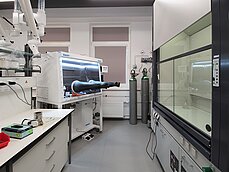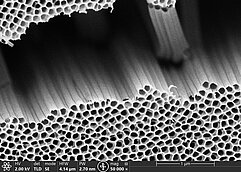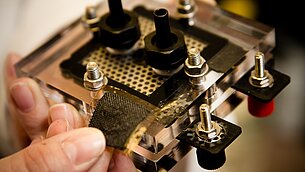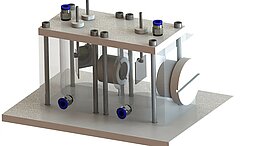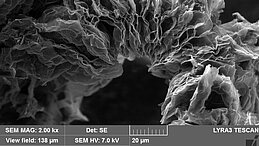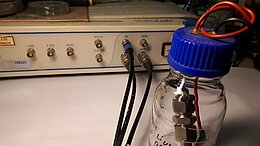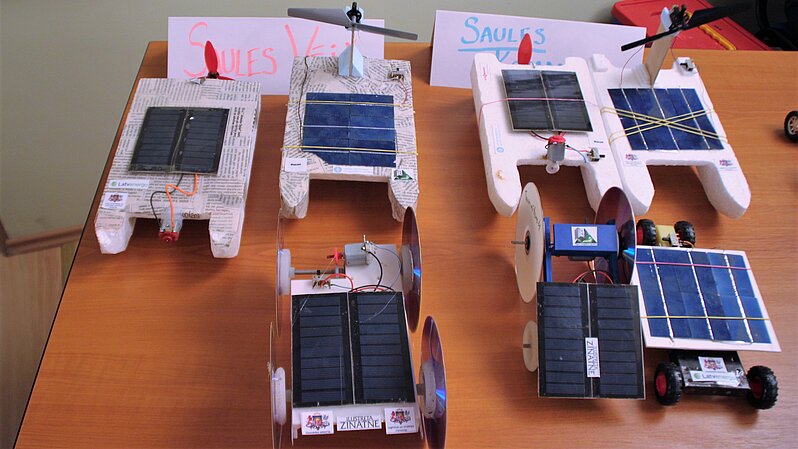Investigations conducted at the Energy Materials Laboratory (EML) is dedicated to the development of knowledge and technologies in three main directions, addressing current issues related to climate neutrality, energy provision, and sustainable solutions in the following areas of materials research:
• Lithium, sodium batteries and supercapacitors (G. Kučinskis)
• Hydrogen production in catalytic processes and storage (A. Knoks)
• Ion-conducting composites and membranes (G. Vaivars)
The head of the laboratory, PhD Gints Kučinskis, is a motivated young researcher who, upon returning from his post-doctoral studies at the Max Planck Institute in Stuttgart (Germany), actively organised the expansion of scientific research directions, the renewal of personnel and the development of the laboratory.
EML was established in 2024 by merging research efforts and bringing together staff with scientific expertise accumulated since the founding of the institute in 1978.. It encompasses the former structures: Semiconductor Materials Department (head A. Lūsis), Laboratory of Solid State Ionics (head G. Bajārs), Laboratory of Hydrogen Energy Materials (head J. Kleperis), Laboratory of Materials for Energy Harvesting and Storage (head G. Kučinskis) and the Laboratory of Chemical Technology (head G. Vaivars).
| Scientific degree | Name Surname | Position | Contact information |
|---|---|---|---|
| Dr.phys. | Gints Kučinskis | Leading researcher and Head of the laboratory | Gints.Kucinskis |
| Dr.chem. | Gunārs Bajārs | Leading researcher | Gunars.Bajars |
| Dr.phys. | Jānis Kleperis | Leading researcher | Janis.Kleperis |
| Asoc.prof.Dr.chem. | Guntars Vaivars | Leading researcher | Guntars.Vaivars |
| Dr.phys. | Līga Grīnberga | Researcher | Liga.Grinberga |
| Dr.phys. | Jūlija Hodakovska | Researcher | Julija.Hodakovska |
| Dr.phys. | Ansis Mežulis | Researcher | Ansis.Mezulis |
| PhD student | Ainārs Knoks | Researcher | Ainars.Knoks |
| PhD student | Pēteris Lesničenoks | Researcher | Peteris.Lesnicenoks |
| PhD student | Kaspars Kaprāns | Researcher | Kaspars.Kaprans |
| PhD student | Ināra Ņesterova | Researcher | Inara.Nesterova |
| Mg. | Einārs Sprūģis | Researcher | Einars.Sprugis |
| Gundars Mežinskis | Guest Researcher | Gundars.Mezinskis | |
| PhD student | Dmitrijs Bogdanovs | Research Assistant | Dmitrijs.Bogdanovs |
| PhD student | Līga Britāla | Research Assistant | Liga.Britala |
| Bc. | Roberts Palmbahs | Research Assistant | Roberts.Palmbahs |
| PhD student | Dāvis Kalniņš | Laboratory Assistant | Davis.Kalnins |
| PhD student | Reinis Kaparkalējs | Laboratory Assistant | Reinis.Kaparkalejs |
| Mg. | Jānis Teterovskis | Laboratory Assistant | Janis.Teterovskis |
| Artis Dēze | Laboratory Assistant | Artis.Deze | |
| Paulis Gurdziels | Laboratory Assistant | Paulis.Gurdziels | |
| Laimons Jēkabsons | Laboratory Assistant | Laimonis.Jekabsons | |
| Paula Malnača | Laboratory Assistant | Paula.Malnaca | |
| Vladimirs Ņemcevs | Laboratory Assistant | Vladimirs.Nemcevs | |
| Rendijs Ronis | Laboratory Assistant | Rendijs.Ronis | |
| Raitis Kaspars Sika | Laboratory Assistant | Raitis.Sika | |
| Ansis Emīls Zīvers | Laboratory Assistant | Ansis-Emils.Zivers |
Lithium, sodium batteries and supercapacitors (G. Kučinskis)
Development and research of materials for Li-ion and Na-ion batteries as well as supercapacitors and other systems, including active material development, analysis, electrode formulation and processing.
Active material development ranges from graphene composite Li-ion anodes to layered transition metal oxides for Na-ion batteries.
Electrode processing activities deal with development of inert protective coatings for active electrode materials and electrodes, aqueous processing, and development of tailored electrode architectures.
Hydrogen production in catalytic processes and storage (A. Knoks)
Synthesis and functionalization (N, quantum dots) of electrocatalytically and photocatalytically active nanomaterials (TiO2, Al2O3) for water splitting and pollution reduction.
CO2 reforming and exploration of catalytic materials for higher hydrocarbons in electrocatalysis.
Carbon materials for hydrogen storage and supercapacitors.
Fuel cells and their application.
Ion-conducting composites and membranes (G. Vaivars)
Synthesis of ion-conducting materials and membranes, characterization of their physical and chemical properties.
Nanostructured ion-conducting composites with nano additives.
Active projects:
EEA and Norway Grants
European Space Agency Requesting Party Activity
Development of Low-Temperature Ionic Liquid-Based Li-Ion Battery Cells (2023-2025)
Horizon Europe
Eliminating VOC from Battery manufacturing through dry or wet processing (NoVOC) (2023-2027)
M-ERA.NET
Accomplished projects:
COST
Hybrid Energy Storage Devices and Systems for Mobile and Stationary Applications (2011-2015)
Nanostructured materials for solid-state hydrogen storage (2011-2015)
European Agricultural Fund for Rural Development (EAFRD)
Development of technology for the drying of grains with active ventilation using ozone (2018-2021)
European Regional Development Fund
Autonomous Wind and Hydrogen Power Supply System (2010-2013)
European Regional Development Fund (LIAA administrated)
Directly driven generator with electricity storage facility from water waves (DD-WWG) (2020)
European Social Fund
Innovative materials for transparent electronics and photonics (2013-2015)
Horizon 2020
CO2-based Electrosynthesis of ethylene oXIDE – CO2EXIDE (2018-2021)
ISSP UL project competition for students and young scientists
Latvian Council of Science
Nanostructured materials for environmentally friendly technologies and energetics (2009-2012)
Latvia – Lithuania-Taiwan Trilateral Scientific Cooperation Program
Materials and processing development for advanced Li ion batteries (2012-2014)
National Research Program
Trends, challenges and solutions of Latvian gas infrastructure development – LAGAS (2019-2021)
National Research Program of Latvia in Materialsciences (2010-2013)
Postdoctoral
Advanced Materials for Sodium Ion Batteries (2019-2022)
Research Cooperation
- Obtained hematite thin film coatings with different impurity metals using advanced spray pyrolysis process; thin films possesses high photo-conductivity and appropriate width of forbidden gap for photocatalytic water splitting.
- Simple method is developed to obtain nanostructured multilayer graphene and modify it with metals/cations for application as electrode material in supercapacitor and for solid state hydrogen storage.
- Self-oriented nanostructured titanium dioxide nanotube coatings are obtained in anodization process, and research performed on influence of various parameters on the formation of this coating at the very beginning.
- In collaboration with the designer created a prototype of Solar Tree to demonstrate “3 in 1” principle of Solar energy harvesting, storage and usage for installation in public areas of the urban environment.
- Research was carried out on the hydrogen adsorption/desorption capacity of palladium and platinum activated natural zeolite using gravimetric and volumetric methods, concluding that zeolite, pre-treated with temperature pulses in inert atmosphere, can be used for hydrogen storage in solid state material (up to 5% by weight).
- We are also conducting research on proton-conducting membranes and catalytic materials for fuel cells and electrolysers. Mixed-conductivity polymer is synthesized from electron-conducting (poli-anilin) and proton-conducting (sulfonated polyether-ether ketone) polymers that can be applied to the electrode-membrane assembly (MEA) of fuel cells. Using electrochemical impedance and spectrophotometric methods, the presence of proton and electron transfer mechanisms for obtained polymer composites has been detected.
- In the field of bio-hydrogen production it has been found that C.sporogenes bacteria is capable of forming hydrogen gas in dark fermentation by processing various biomass production residues (whey from dairy and crude glycerol from bio-diesel plants in Latvia) with the hydrogen production rate of 1.5 mmol H2/l/h. Studies have shown that the use of micro-organisms from our own collection can successfully ferment various food residues, yielding hydrogen in gas phase. By increasing efficiency of the process it will be possible to transfer biomass residue into valuable energy carrier, hydrogen, which can be further used for electricity generation in food and chemical industries.
- Prototype bioreactor has been created for pilot studies with hydrogen (and methane) production in bacterial fermentation process, also providing process control and reliable data acquisition. Micro-sensors, as well as optical sensors, are built in the bioreactor to test gas environment. It has been found that mixing and aeration with an inert gas increases the release of hydrogen in gas phase.
- An electrophoresis equipment and technology for metal ceramic coatings of solar energy collectors are being developed. Homogeneous TiO2 films are produced by sol and suspension electrophoresis, and the method is promising in applications on metal substrates and fibers. It has been detected that thin films, crystallized at 500 °C, are mainly composed of anatase form, while in thicker films the proportion of rutile forms will increase. TiO2 thin layer photo activity varies significantly depending on the surface area and dopants (Fe2O3, WO3).
- A new method of magnetron sputtering of high charge capacity has been developed for production of cathode thin film material, based on LiFePO4/C, for lithium-ion batteries. Electrochemical parameters of cathode material/Li-ion electrolyte boundary have been defined for cathode material charge - discharge states. It has been found that the largest double layer capacitance and the smallest charge transfer resistance is in the discharged state, but Li-ion diffusion coefficient minimum value is reached at the equilibrium state. Electrophoretic deposition method is elaborated for obtaining thin films of LiFePO4. New model describing extraction and injection mechanism of lithium ions in LiFePO4 thin films has been developed.
- The electrophoretic deposition (EPD) method has been developed to obtain multilayer reduced graphene oxide (rGO) films as anode material. High charge capacity of films is ensured by lamellar structure and large surface area of electrode. Composite anode material TiO2/Fe2O3/rGO obtained by EPD showed very high charge capacity and cycling stability.
Latvia:
- Ltd Ambitech Group AG
- Ltd Multipla Energy
- Ltd Eko Osta
- JSC “Sidrabe”
- JSC "Riga Electric Machine Building Works"
- Ministry of Environmental Protection and Regional Development
- Ministry of Education and Science
- Latvian Science Council
- Latvian Academy of Science
- Latvian Hydrogen Association
- Riga Technical University IIEE
- Latvian State Institute of Physical Energy
- Latvian State Wood Chemistry Institute
- Riga Technical University Neorganic Chemistry Institute
- UL Faculty of Biology
- UL Faculty of Chemistry
- UL Faculty of Business Management and Economy
- Riga Energy Agency
Estonia
- University of Tartu
Lithuania:
- Lithuanian Institute of Energetic, Kaunas
- University of Vilnius - Department of Physics
- Klaipeda University, Marine Research Institute
Poland:
- Warsaw University
Estonia:
- Tartu University
Germany:
- Max-Planck-Institut für Festkörperforschung, Stuttgart
- Kassel University
- Institute of Solid State Research, Forschungszentrum Jülich, Jülich
- Institute of Physics Freiburg University
EU:
- European Hydrogen Association
Taiwan:
- National Cheng Kung University, Materials Science and Engineering Department
- Vanung University Taipei, Department of Electro-Optical Engineering
Kleperis J., Bajārs G., Grīnberga L., Vaivars G., Purāns J., Vītiņš Ģ., Kučinskis G., From electrochromic phenomena to energy harvesting and storage—an overview of solid state ionics research at the Institute of Solid State Physics, University of Latvia, (2023) Journal of Solid State Electrochemistry, 27 (7), pp. 1641 - 1660, DOI: 10.1007/s10008-023-05419-8
Lithium, sodium batteries and supercapacitors
Gauckler C., Kucinskis G., Pfeiffer L.F., Abdellatif A.A., Tang Y., Kübel C., Maroni F., Gong R., Wohlfahrt-Mehrens M., Axmann P., Marinaro M.,MgO coated P2-Na0.67Mn0.75Ni0.25O2 layered oxide cathode for Na-Ion batteries, (2024) Journal of Power Sources Advances, 25, art. no. 100135, DOI: 10.1016/j.powera.2024.100135
Nesterova I., Britala L., Sarakovskis A., Kruze B., Bajars G., Kucinskis G., The Impact of Graphene in Na2FeP2O7/C/Reduced Graphene Oxide Composite Cathode for Sodium-Ion Batteries, (2023) Batteries, 9 (8), art. no. 406, DOI: 10.3390/batteries9080406
Britala L., Marinaro M., Kucinskis G., A review of the degradation mechanisms of NCM cathodes and corresponding mitigation strategies, (2023) Journal of Energy Storage, 73, art. no. 108875, DOI: 10.1016/j.est.2023.108875
Kucinskis G., Bozorgchenani M., Feinauer M., Kasper M., Wohlfahrt-Mehrens M., Waldmann T., Arrhenius plots for Li-ion battery ageing as a function of temperature, C-rate, and ageing state – An experimental study, (2022) Journal of Power Sources, 549, art. no. 232129, DOI: 10.1016/j.jpowsour.2022.232129
Kavaliukė V., Nesterova I., Kežionis A., Balčiūnas S., Bajars G., Šalkus T., Kucinskis G., Combined conductivity and electrochemical impedance spectroscopy study of Na2FeP2O7 cathode material for sodium ion batteries, (2022) Solid State Ionics, 385, art. no. 116024, DOI: 10.1016/j.ssi.2022.116024
Kucinskis G., Nesterova I., Sarakovskis A., Bikse L., Hodakovska J., Bajars G., Electrochemical performance of Na2FeP2O7/C cathode for sodium-ion batteries in electrolyte with fluoroethylene carbonate additive, (2022) Journal of Alloys and Compounds, 895, art. no. 162656, DOI: 10.1016/j.jallcom.2021.162656
Kucinskis G., Kruze B., Korde P., Sarakovskis A., Viksna A., Hodakovska J., Bajars G., Enhanced Electrochemical Properties of Na0.67MnO2 Cathode for Na-Ion Batteries Prepared with Novel Tetrabutylammonium Alginate Binder, (2022) Batteries, 8 (1), art. no. 6, DOI: 10.3390/batteries8010006
Bozorgchenani M., Kucinskis G., Wohlfahrt-Mehrens M., Waldmann T., Experimental Confirmation of C-Rate Dependent Minima Shifts in Arrhenius Plots of Li-Ion Battery Aging, (2022) Journal of the Electrochemical Society, 169 (3), art. no. 030509, DOI: 10.1149/1945-7111/ac580d
Kucinskis, G., Bajars, G., Bikova, K., Kaprans, K., Kleperis, J., Microstructural Influence on Electrochemical Properties of LiFePO4/C/Reduced Graphene Oxide Composite Cathode, (2019) Russian Journal of Electrochemistry, 55 (6), pp. 517-523., DOI: 10.1134/S1023193519060120
Hydrogen production in catalytic processes and storage
Urbonavicius M., Varnagiris S., Mezulis A., Lesnicenoks P., Knoks A., Richter C., Milcius D., Meirbekova R., Gunnarsson G., Kleperis J., Hydrogen from industrial aluminium scraps: Hydrolysis under various conditions, modelling of pH behaviour and analysis of reaction by-product, (2024) International Journal of Hydrogen Energy, 50, pp. 431 - 446, DOI: 10.1016/j.ijhydene.2023.09.065
Mezulis A., Richter C., Lesnicenoks P., Knoks A., Varnagiris S., Urbonavicius M., Milcius D., Kleperis J., Studies on Water–Aluminum Scrap Reaction Kinetics in Two Steps and the Efficiency of Green Hydrogen Production, (2023) Energies, 16 (14), art. no. 5554, DOI: 10.3390/en16145554
Lesnicenoks P., Knoks A., Piskunov S., Jekabsons L., Kleperis J., N-Graphene Sheet Stacks/Cu Electrocatalyst for CO2 Reduction to Ethylene, (2022) Electrochem, 3 (2), pp. 229 - 238, DOI: 10.3390/electrochem3020015
Lisovski O., Piskunov S., Bocharov D., Zhukovskii Y.F., Kleperis J., Knoks A., Lesnicenoks P., CO2 and CH2 Adsorption on Copper-Decorated Graphene: Predictions from First Principle Calculations, (2022) Crystals, 12 (2), art. no. 194, DOI: 10.3390/cryst12020194
Mezulis A., Kleperis J., Lesnicenoks P., Zemite L., Prospects of Decarbonizing Industrial Areas in the Baltic States by Means of Alternative Fuels, (2022) Journal of Ecological Engineering, 23 (8), pp. 152 - 161, DOI: 10.12911/22998993/150748
Olins R., Lesnicenoks P., Kleperis J., Knoks A., Lukosevics I., Electrochemical exfoliation-streamline method for synthesis of nitrogen doped graphene, (2021) Chemija, 32 (1), pp. 9 - 16, DOI: 10.6001/CHEMIJA.V32I1.4396
Knoks A., Kleperis J., Bajars G., Grinberga L., Bogdanova O., WO3 as Additive for Efficient Photocatalyst Binary System TiO2/WO3, (2021) Latvian Journal of Physics and Technical Sciences, 58 (6), pp. 24 - 34, DOI: 10.2478/lpts-2021-0043
Kleperis J., Boss D., Mezulis A., Zemite L., Lesnicenoks P., Knoks A., Dimanta I., Analysis of the Role of the Latvian Natural Gas Network for the use of Future Energy Systems: Hydrogen from Res, (2021) Latvian Journal of Physics and Technical Sciences, 58 (3), pp. 214 - 226, DOI: 10.2478/lpts-2021-0027
Plavniece A., Volperts A., Dobele G., Zhurinsh A., Kaare K., Kruusenberg I., Kaprans K., Knoks A., Kleperis J., Wood and black liquor-based n-doped activated carbon for energy application, (2021) Sustainability (Switzerland), 13 (16), art. no. 9237, DOI: 10.3390/su13169237
Ion-conducting composites and membranes
Zabolockis, R.J., Sondars, M., Vaivars, G., Reinholds, I., Gostilo, V., Malgin, V., Kizilov, A., Lescinskis, A., Felsharuk, A., Avotina, L., Teimane, A.S., Sprugis, E., Pajuste, E., Graphene-based electrochemical system for tritium enrichment, (2024) Nuclear Fusion, 64 (2), art. no. 026022, DOI: 10.1088/1741-4326/ad1af4
Pakalniete, L.D., Maskova, E., Zabolockis, R.J., Avotina, L., Sprugis, E., Reinholds, I., Rzepna, M., Vaivars, G., Pajuste, E., Critical Evaluation of the Methods for the Characterization of the Degree of Sulfonation for Electron Beam Irradiated and Non-Irradiated Sulfonated Poly(ether ether ketone) Membranes, (2023) Materials, 16 (18), art. no. 6098, DOI: 10.3390/ma16186098
Pajuste, E., Reinholds, I., Vaivars, G., Antuzevičs, A., Avotiņa, L., Sprūģis, E., Mikko, R., Heikki, K., Meri, R.M., Kaparkalējs, R., Corrigendum to Evaluation of radiation stability of electron beam irradiated Nafion® and sulfonated poly(ether ether ketone) membranes, (2022) Polymer Degradation and Stability, 202, art. no. 110008, DOI: 10.1016/j.polymdegradstab.2022.110008
Fedorenko, D., Vaivars, G., Composite membranes of sulfonated poly(Ether ether ketone) with active carbon: Composite preparation and investigation of their properties for potential application for co2 electrochemical reduction, (2020) Medziagotyra, 26 (4), pp. 444-450., DOI: 10.5755/j01.ms.26.4.24000
Vaivars, G., Krūkle-Bērziņa, K., Markus, M., Modelling ir spectra of sulfonated polyether ether ketone (Speek) membranes for fuel cells, (2020) Key Engineering Materials, 850 KEM, pp. 138-143., DOI: 10.4028/www.scientific.net/KEM.850.138
Pajuste, E., Reinholds, I., Vaivars, G., Zicans, J., Meri, R.M., Avotina, L., Sprugis, E., Rzepna, M., Radiation stability of electron beam irradiated high degree sulfonated poly(ether ether ketone) membranes for the applications in nuclear facilities, (2024) Polymer Degradation and Stability, 219, art. no. 110615, DOI:10.1016/j.polymdegradstab.2023.110615
Kaparkalējs, R., Sprūģis, E., Vaivars, G., A Study of Osmosis Rate Through Several Proton Conducting Polymer Composite Membranes, (2021) Medziagotyra, 27 (4), pp. 466-469. DOI: 10.5755/j02.ms.27892
Vaivars, G., Krūkle-Bērziņa, K., Markus, M., Modelling ir spectra of sulfonated polyether ether ketone (Speek) membranes for fuel cells, (2020) Key Engineering Materials, 850 KEM, pp. 138-143., DOI: 10.4028/www.scientific.net/KEM.850.138
Sprugis, E., Vaivars, G., Merijs Meri, R., A study of mechanical properties of polymer composite membranes with various ionic liquids at elevated temperatures, (2019) Medziagotyra, 25 (1), pp. 66-70., DOI: 10.5755/j01.ms.25.1.18933
1. Latvian Patent Application No P-18-21 (19.03.2018) Flexible two-layer pavement from elements with specific forms from rubber granules. Rims Vaitkus, Elmars Baltins, Peteris Lesnicenoks, Vladimirs Nemcevs, Janis Kleperis, Institute of Solid State Physics of University of Latvia.
2. Latvian Patent Application No. P-17-58 (15.09.2017) Industrially manufactured flexible covering of roads and grounds, and the process of its’ creation; Rims Vaitkus, Elmars Baltins, Vladimirs Nemcevs, Janis Kleperis, Institute of Solid State Physics of University of Latvia.
3. Latvian Patent No 14701 (0.10.2013). Method of creating capillary channels. Jānis Kleperis, Jurijs Kuzņecovs, Jānis Baumanis.
4. Latvian Patent No 14698, 2013. Fluid Level Balancing System. Jānis Kleperis, Jānis Straumēns.
5. Latvian Patent No 14454A (20.12.2011) Device for Conversion of Liquids Into Gaseous Combustible. J. Kuznecovs, M. Morozs, V. Strizevskis, J. Kleperis.
6. Latvian patent No LV13811 (09.10.2009) DC motor drive with a hydrogen fuel cell. A.Purviņš, O. Krievs, L. Ribickis, J. Kleperis
7. Latvian patent Nr. LV 13960, 2009, A new way for the synthesis of polymer-bonded sulphonated PEEK polymers. 2. H. Luo, G. Vaivars, J. Kleperis
8. Latvian patent LV 13710, 2008. Water-operated heat and electricity supply system. M.Vanags, V.Ņemcevs, J.Kleperis
9. United States Patent 4251138 · Filed: 11/30/1978 · Published: 02/17/1981; Method of producing solid electrochrome element. Lusis Andrei R., Klyavin Yanis K., Zamozdik Talivaldis V., Lagzdons Juris L., Rode Oyars A., Pinnis Yanis Y.
Solar Cup, solar-powered and self-made model competition for school youth; annual event 3rd Saturday in May, 2008-2018. https://www.cfi.lu.lv/en/events/solar-cup/
International Exhibition of Innovations and Innovation MINOX, annual event 2-3 days of October, 2014 - 2018, Riga. ISSP UL stand, organized by laboratory scientists and engineers. http://www.minox.lv/home/; http://www.izgudrotaji.lv/?s=1237785432
International Exhibition Environment and Energy, each year 3-4 days in October, Riga, Kipsala, 2007-2018; ISSP UL stand, organized by laboratory scientists and engineers. Pēteris Lesničenoks (Latvian): https://www.youtube.com/watch?v=GwG400m1gAc
Science Night - laboratory young scientists (students) take part every year in the past ISSP now LU FMF. http://www.zinatniekunakts.lv/
Publications popular science journa “Energy and World” (Latvian): http://www.energijaunpasaule.lv/
1. Hydrogen is everywhere, also in Institute of Solid State Physics UL J. Kleperis, Energy and World, 2016 June-July, No 3 (98)), pp 58-61.
2. Insight into the 10 years of Laboratory of Hydrogen Energy Materials Laboratories ISSP UL. J. Kleperis, Energy and the World, 2016 August - September, No 4 (99)), pp. 52-57.
3. Solar energy in the presence of special materials reduces anthropogenic air pollution. A. Knoks, Energy and the World, 2018 April-May, No. 2 (109), p. 61-65
